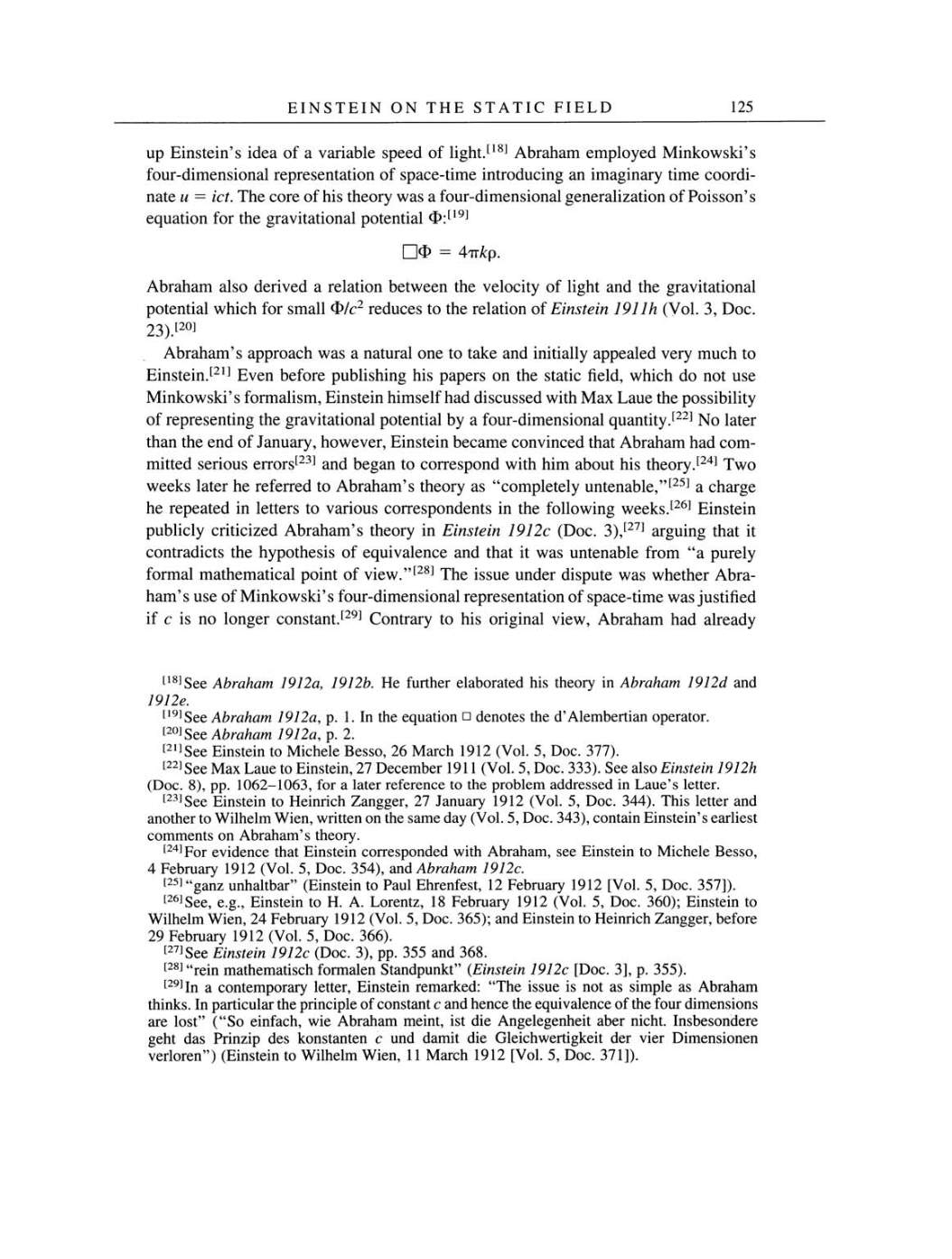EINSTEIN
ON
THE
STATIC
FIELD 125
up
Einstein's idea of
a
variable
speed
of
light.[18]
Abraham
employed
Minkowski's
four-dimensional
representation
of
space-time introducing
an
imaginary
time coordi-
nate
u
=
ict.
The
core
of
his
theory
was a
four-dimensional
generalization
of Poisson's
equation
for the
gravitational potential O:[19]
£
=
4tt&P.
Abraham also derived
a
relation between the
velocity
of
light
and
the
gravitational
potential
which for small
O/c2
reduces
to
the relation of Einstein
1911h
(Vol.
3,
Doc.
23).[20]
Abraham's
approach
was a
natural
one
to
take
and
initially appealed
very
much
to
Einstein.[21]
Even before
publishing
his
papers
on
the
static
field,
which
do not
use
Minkowski's
formalism,
Einstein himself
had
discussed
with
Max Laue the
possibility
of
representing
the
gravitational potential
by a
four-dimensional
quantity.[22]
No later
than the end of
January,
however,
Einstein became convinced that Abraham had
com-
mitted serious
errors[23]
and
began
to
correspond
with him about
his
theory.[24]
Two
weeks later
he
referred
to
Abraham's
theory
as
"completely
untenable,"[25] a
charge
he
repeated
in
letters
to
various
correspondents
in
the
following
weeks.[26]
Einstein
publicly
criticized Abraham's
theory
in
Einstein 1912c
(Doc.
3),[27]
arguing
that
it
contradicts the
hypothesis
of
equivalence
and
that
it
was
untenable from "a
purely
formal mathematical
point
of
view."[28]
The issue under
dispute
was
whether Abra-
ham's
use
of Minkowski's four-dimensional
representation
of
space-time
was
justified
if
c
is
no
longer
constant.[29]
Contrary
to his
original view,
Abraham had
already
[18]See
Abraham
1912a, 1912b.
He further elaborated
his theory in
Abraham 1912d and
1912e.
[19]See
Abraham
1912a,
p. 1.
In
the
equation
denotes
the
d'Alembertian
operator.
[20]See
Abraham
1912a,
p.
2.
[21]See
Einstein
to
Michele
Besso, 26
March
1912
(Vol. 5,
Doc.
377).
[22]See
Max Laue
to Einstein, 27
December
1911
(Vol. 5,
Doc.
333).
See
also Einstein 1912h
(Doc. 8), pp.
1062-1063,
for
a
later reference
to
the
problem
addressed
in
Laue's
letter.
[23]See
Einstein
to
Heinrich
Zangger,
27
January
1912
(Vol. 5,
Doc.
344).
This letter
and
another
to
Wilhelm
Wien,
written
on
the
same
day (Vol. 5,
Doc.
343),
contain Einstein's earliest
comments
on
Abraham's
theory.
[24]For
evidence that Einstein
corresponded
with
Abraham,
see
Einstein
to
Michele
Besso,
4
February
1912
(Vol. 5,
Doc.
354),
and
Abraham
1912c.
[25]"ganz
unhaltbar"
(Einstein to
Paul Ehrenfest,
12 February
1912
[Vol.
5,
Doc.
357]).
[26]See,
e.g.,
Einstein
to H. A. Lorentz,
18 February
1912
(Vol.
5,
Doc.
360);
Einstein
to
Wilhelm
Wien, 24
February
1912
(Vol. 5,
Doc.
365);
and Einstein
to
Heinrich
Zangger,
before
29 February
1912
(Vol.
5,
Doc.
366).
[27]See
Einstein 1912c
(Doc. 3),
pp.
355
and
368.
[28]"rein mathematisch formalen
Standpunkt"
(Einstein
1912c
[Doc. 3],
p.
355).
[29]In
a
contemporary
letter,
Einstein remarked: "The issue
is not
as
simple
as
Abraham
thinks.
In
particular
the
principle
of
constant
c
and hence the
equivalence
of
the
four dimensions
are
lost"
("So
einfach,
wie Abraham
meint,
ist die
Angelegenheit
aber nicht. Insbesondere
geht
das
Prinzip
des konstanten
c
und damit die
Gleichwertigkeit
der vier Dimensionen
verloren") (Einstein
to
Wilhelm
Wien,
11
March
1912
[Vol. 5,
Doc.
371]).
